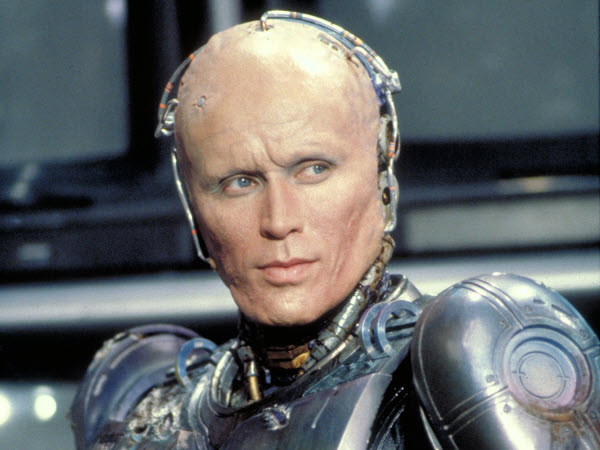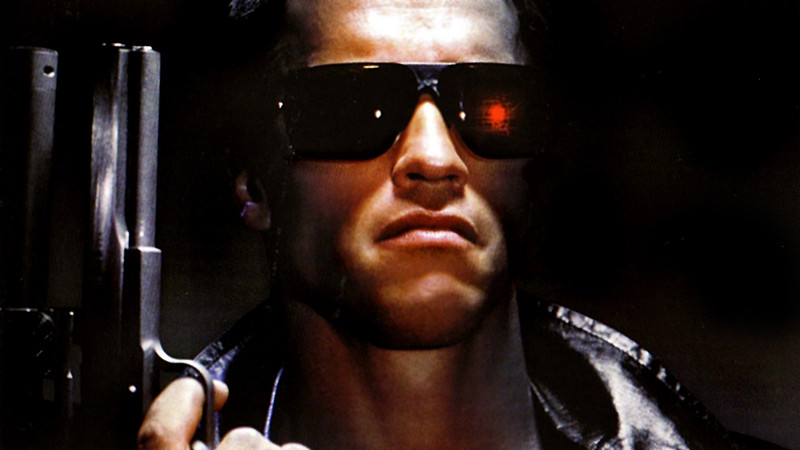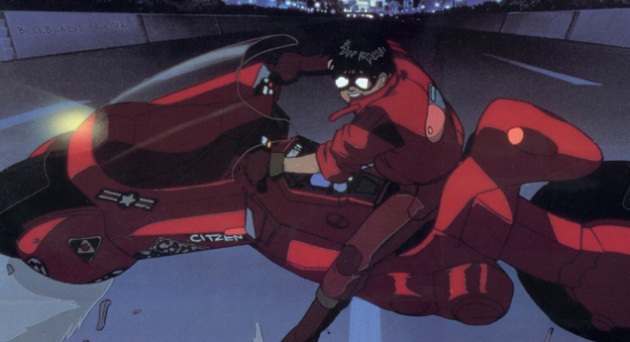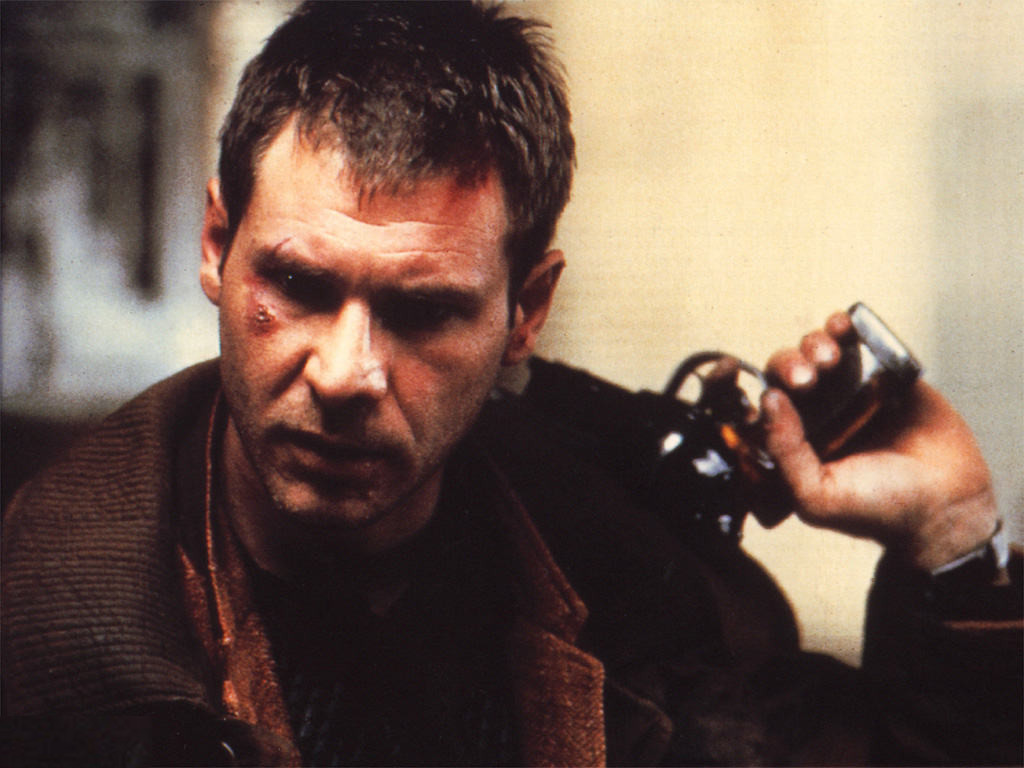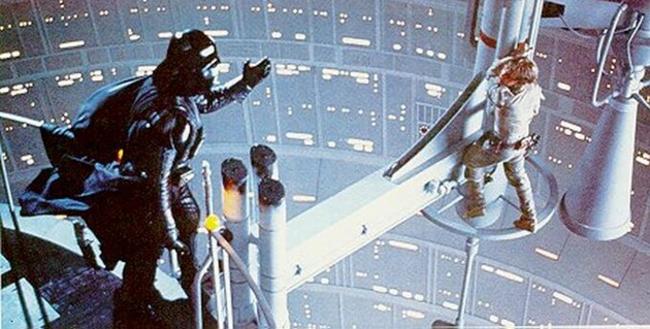7. Robocop (1987)
No remake could ever sully the memory of this vintage 80’s classic—its sheer awesomeness is as invulnerable as Robocop’s Kevlar-reinforced body armor. It’s the simplest of revenge stories: cop gets shot to pieces, cop gets rebuilt as a super-cyborg, cop goes after the gang that murdered him.
Along the way, we’re treated to satiric jabs at American consumerism, simple-minded “tough on crime” approaches to law enforcement, and human identity in an increasingly technology-driven world, carried along by wonderfully bloody, explody action.
6. The Terminator (1984)
Do you hate the fact that Hollywood science-fiction movies almost always place heavy stress on action? Lay the blame here, the first movie to blend the action and sci-fi genres in a way that feels natural.
Schwarzeneggar gave one of his best performances (face it, the man can’t act) and James Cameron began a very lucrative career using story elements cribbed from the work of Harlan Ellison, and chase scenes that rival those in Bullit or The Road Warrior. Cameron took an upward trajectory from here to Aliens, leveled out at The Abyss and Terminator 2, and it’s been downhill from there for everything but his bank account.
5. Brazil (1985)
Terry Gilliam’s strongest and most cohesive work, Brazil celebrates the triumph of imagination over the mundane drudgery of everyday life, and satirizes a modern world that values bureaucracy and vanity over the individual and personal virtue.
The film’s themes in many ways mirror the director’s struggles in getting the finished product distributed in a way that was true to his original vision; the early studio cut took out a lot of the run time, including the final scene in which Jonathan Pryce’s character is left in a catatonic state, fully retreated into the imaginative world he had always yearned for.
Like many of the best sci-fi films of the era, Brazil ups the ante in the creation of new worlds, blending a futuristic dystopia with the oddly charming elements of a 1940’s cartoon, complete with period wardrobes and Rude Goldberg devices.
4. Akira (1988)
There had been an audience for anime outside of Japan prior to the release of Katsuhiro Otomo’s legendary film (anybody remember Star Blazers?), but nobody ever expected to see anything taken to this level.
Akira surpasses just about everything put out by Disney Studios, achieving a richness of detail that outdoes even the superlative live-action work on Blade Runner. The difference here is that Neo-Tokyo feels lived in, becoming a fully integrated environment that is as realistic as it is immense.
This is a master class in the art of world-building in science fiction. Crown and ensemble scenes are played out with a layered complexity missing in most animated entertainment, and Otomo matches the incomparable visuals with a story that touches on the very metaphysics of the cosmos. Not just one of the best animated movies ever, but one of the best science fiction movies, period.
3. Back To The Future (1985)
As long as we’re on the subject of Spielbergian nostalgia, how about a trip back to the simpler days of the 1950’s, which were a wonderful time so long as you overlook the racism, sexism, and rapist jocks. Kudos to the filmmakers for working accidental near-incest into the storyline of a mainstream Hollywood film and not making it utterly nightmarish. Not so much with the near-sexual assault of Marty McFly’s mom, a strangely dark choice for what is otherwise a family film (creepy sexuality is nothing new to science fiction—just ask George Lucas).
Though directed by Robert Zemeckis, producer Spielberg’s fingerprints are all over this thing—even Alan Silvestri’s score has a distinctly John Williams-esque feel to it. Light, goofy fun that struck a powerful chord with audiences and inspired two interesting-but-lesser sequels. It’s weird (for me) to think that 1985 is as far from us in the present day as the mid-’50’s were from 1985.
2. Blade Runner (1982)
Pick a version, any version. Enjoy voiceover narration? Then the original theatrical cut is for you. Not so crazy about hearing Harrison Ford drone on for over two hours? Go with any one of the four following director’s cuts (there are five versions now, right? Or did Ridley Scott do another one while we weren’t looking?)
Whichever you decide, you’re bound to enjoy a tour-de-force display of production design and visual effects mastery that has yet, to this day, to be topped in a live action film, and that holds up more than 30 years later, even when compared to today’s CGI-engorged extravaganzas. With studied, methodical pacing that sets just the right tone, Ridley Scott adapted Philip K. Dick’s “Do Androids Dream of Electric Sheep?” into a stunning and thought-provoking analysis of the essence of humanity and human identity (assuming you’re not watching the theatrical cut).
1. The Empire Strikes Back (1980)
In the late 1970s and early 1980s, Star Wars was everywhere (times haven’t changed much). And The Empire Strikes Back kicked the crap out of it. It’s a rare—and the most often sited—example of a sequel being better by an order of magnitude than a great predecessor. It looks better, the story moves better, and it operates on a level of emotional richness the first Star Wars never approaches (and was conspicuously absent from every one of the prequels).
Darth Vader, a mid-level minion in the first film, becomes a bona fide top-drawer bad guy here. Luke Skywalker, once a naïve and inexperienced youth, starts down the road to a hard-won manhood. We get a cool new character in Yoda, and the best look at what the Star Wars universe is like when things aren’t going so good for the protagonists. It’s safe to say this was the height of the franchise, a feat Lucasfilm was never able to pull off again.
Author Bio: Scot Mason lives in Tucson, AZ. He is the author of the blogs Hawaii Timewarp, Eastern Trails, Scotty’s Movies N’ Tunes, and Tucson Only Kind Of Sucks. He once lived in a shack in the middle of an abandoned sugercane field full of giant spiders and rats, because YOLO.
